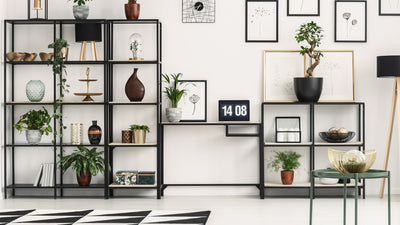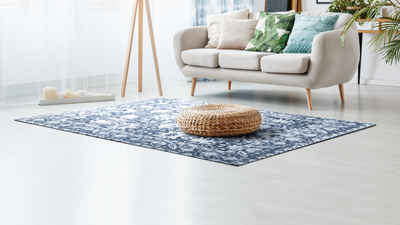How to Find the Right Room Divider
While it can be nice imagining you live in a larger home with many different rooms dedicated to your needs, your reality may more likely be a smaller home or an apartment. Creating a cohesive design for your small home can be hard, especially if you have a limited number of multi-purpose rooms or your home follows an open plan. If your rooms feel chaotic and purposeless, it may be a sign to start distinguishing your space. So, how do you create a brand new space without adding any walls?
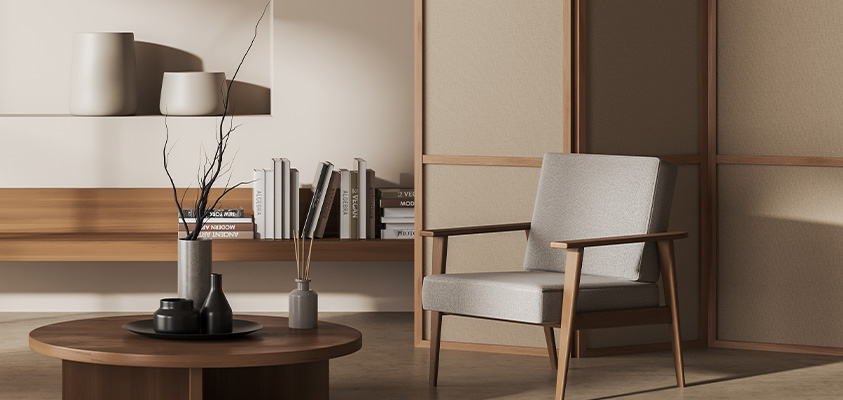
Room dividers are a great way to make the best of the space you have. They are an affordable and stylish furniture solution for those who can’t afford a full home renovation, or who only need temporary barriers. Room dividers come in all sorts of shapes, sizes, and materials, and they can be multifunctional. Some include shelving, others function as art pieces. Whatever you're looking for, the search stops here with Artiss.
What is a zone?
Zones are specific areas of your home that are dedicated to certain activities or habits. You probably already have some zones in your house. Do you have a specific chair where you drink your morning coffee? Do you have a window where you always set your yoga mat? Do you have a man cave, she-shed or craft room? Then you’ve already started the zoning process.
Zones don’t have to be heavily defined by walls and police tape. Room dividers are a great way to do this subtly, or you can lean in and turn them into functional dividers: your space, your way.
Why do dedicated zones in the home matter?
The concept of creating zones in the home is easy to understand when you break it down conceptually. You don’t normally keep your cutlery in the bedroom, or a couch in the bathroom. Each room serves a purpose – the kitchen is for cooking, the living room is for relaxing, and the bedroom is for sleeping. However, it’s easy for the lines to be blurred when you live in a small home, or apartment, or live with children or housemates. Nothing highlights this more than when you have to work from home.
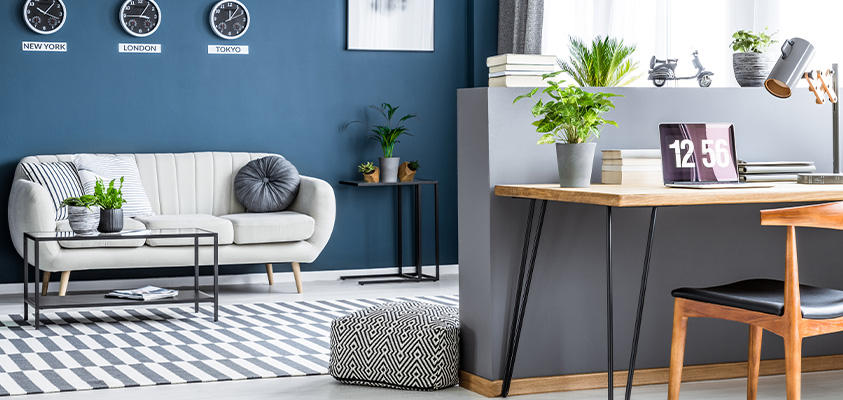
While the statistics are generally positive, some citing up to 77 per cent greater productivity, there are plenty of people struggling with the changes. In a Nulab survey conducted over the 2020 Covid-19 crisis, around 29 per cent of employees worked in a home office and almost 43 per cent of workers perceived remote work to be less productive.
When asked about the biggest problems when it comes to working from home, most people cite distractions in the top three, commonly referring to distractions from children, pets, partners, or simply having other people in a shared space.
If you’ve ever sat at the dining table and lamented another missed deadline while your cat knocks over your favourite mug or your housemate complains about the noise from your computer fan, it's a sign that you could use some space.

Another important zoning issue relates to sleep. If you work, entertain and sleep in the same room, you’re more likely to develop poor sleep hygiene. For starters, the lights from technology in our room, even just the ambient lighting from chargers, have been shown to disrupt our sleep. Blue light in particular – emitted by computers, TVs, smartphones and tablets – has been shown to disrupt our sleep by suppressing the natural release of melatonin. There’s also just the temptation of binge-watching or working into the night, keeping us up beyond a healthy time. Creating clear boundaries in your home involves keeping these activities separate, for better health.
Uses for room dividers
Beyond the practical aspect of using a room divider to create areas for different purposes, you may also look to use more screens for the following reasons.
Creating a focal point
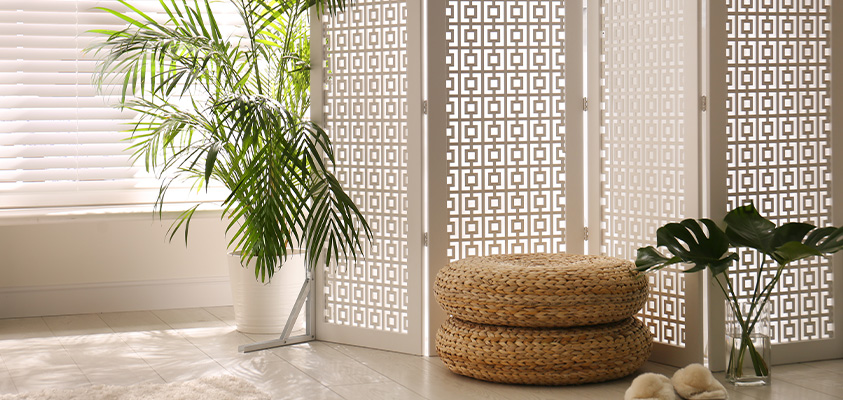
A decorative room divider can divert your guests' attention to a stand-out focal point. This focal point will naturally guide someone through your home and helps to show off your aesthetic. There are all kinds of things you can use as focal points, but a room divider is an ideal focal point for a small open space.
Providing an extra surface
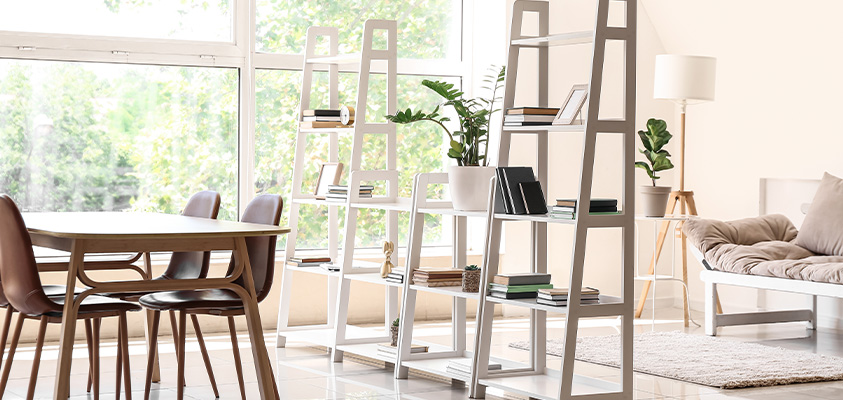
Running out of surface space or wall room? A room divider can help you instantly create much-needed space, whether it’s for extra shelving or wall space to hang artwork.
Giving extra privacy
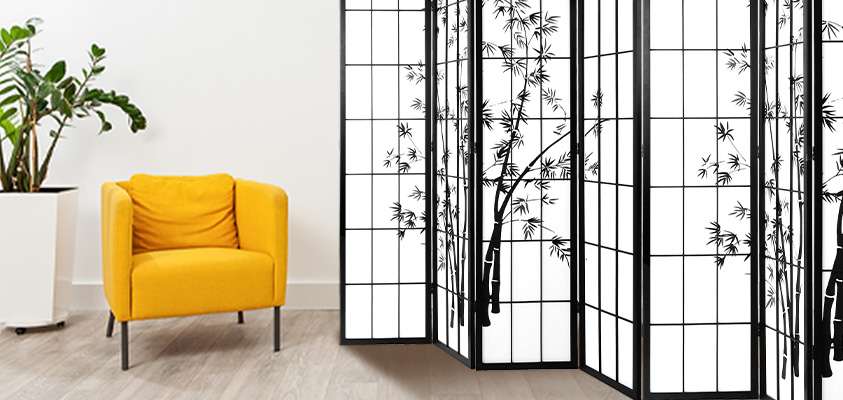
If you’ve ever shared a room, you’ll know it’s often tempting to draw a line across the room. With a room divider, you don’t have to! A physical barrier between you and the outside world, no matter how small, can be wildly beneficial, whether you want to change clothes, protect your belongings, or just have a bit of peace for your morning tea. You might even use them in your shop or restaurant to give a sense of intimacy and privacy between customers, or hide back rooms, kitchens and changing rooms from view.
Types of room dividers
Foldable screens/accordion dividers
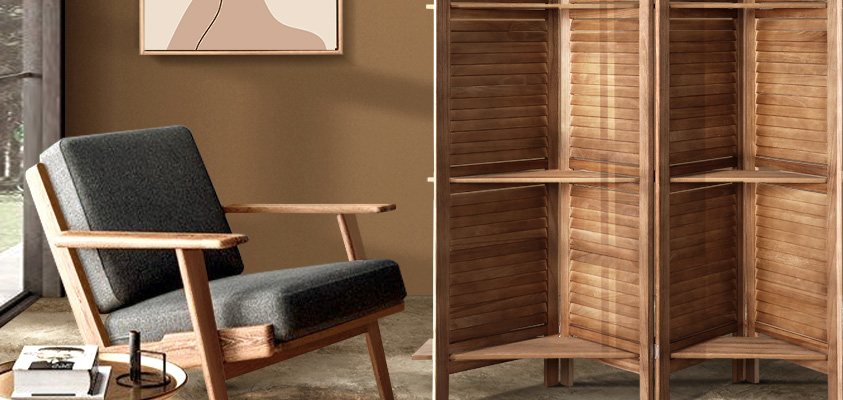
The easiest and most recognisable of room dividers, foldable screens are perfect for someone who doesn’t want to invest much money, time or effort, but still wants to spruce up their space. These free-standing screens can be pulled out and folded away at a moment’s notice, perfect for when you have a multi-use space that you only want to close off sometimes. Our foldable screens also make the perfect artistic or decorative pieces that can casually be placed anywhere in the home. You can find our foldable screens and dividers in all kinds of materials, even some foldable screens with shelves. You have to place these panels in a zig-zag fashion to keep them upright, so they have a slightly larger footprint than other options.
Hanging room dividers
If you grew up in Australia, you may remember seeing teachers in school move grey fabric panels to combine classrooms. Those are hanging room dividers, and they’re not just practical for schools. A semi-permanent structure, these screens can be pulled, folded, extended, rotated or lowered to create a wall when you need it. Beaded curtains, stacking panels and bi-fold panels can all act as hanging room dividers – even regular curtains can become a divider with a bit of ingenuity.
Storage room divider

Also called a bookcase room divider, these dividers are filled with shelves so that you can store books or curios while also defining your space. Not all room dividers are bookcases, but many bookcases can be room dividers. There are, however, a few caveats:
-
The best storage room divider is open – you can see the shelves on both sides.
-
Some slimmer bookcases can topple if not properly balanced, and may need to be attached to an adjacent wall. If you want freestanding furniture, check with the seller or manufacturer before purchasing.
-
Because of weight limits, storage dividers might not be able to reach high enough for your ideal feeling of privacy.
Permanent room dividers
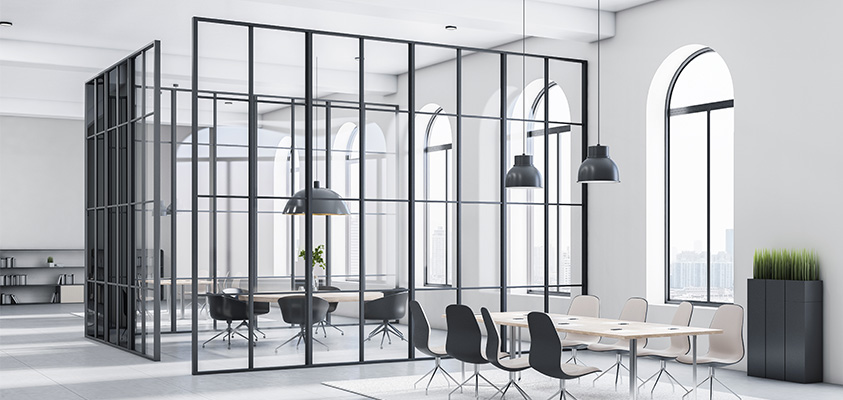
A panel fixed to the ceiling, floor or both as a permanent feature, but not a full wall. These room dividers have the freedom to be more expressive focal points, but are immobile – once they’re in, they’re in!
Types of materials
Room dividers can be made out of practically anything, but some materials are better than others, depending on your style and expected functionality.
Fabric
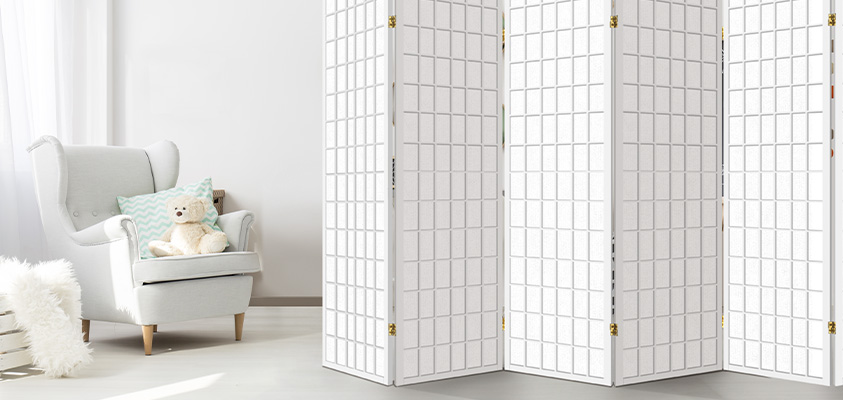
Fabric panels are a great all-around choice. These panels can include a base construction that is covered in fabric, or they can be a fabric screen used as backing for a frame. Fabric panels will suit modern and classic homes alike, as they come in a wide variety of prints or solid colours.
Pros of fabric room dividers:
-
Affordable.
-
Portable.
-
Absorbs sound.
-
Can be easy to repair or reupholster.
Cons of fabric room dividers:
-
Not as durable as other options.
-
It will stain more easily.
-
Some fabric absorbs odours.
Wood
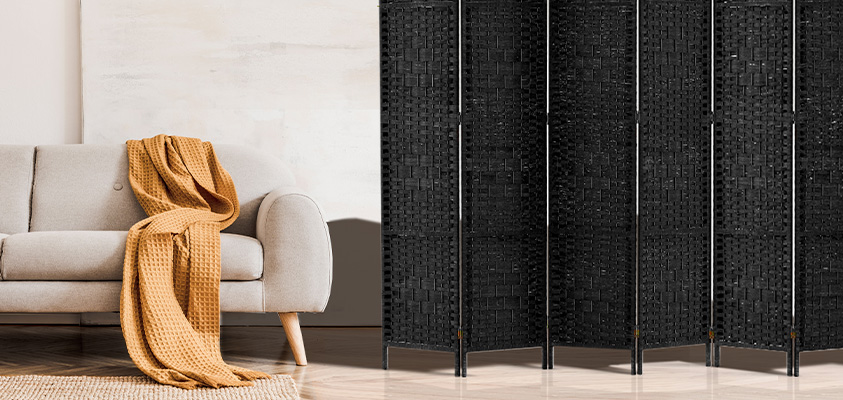
When we think of room dividers, one of the most recognisable types is possibly the shoji, a type of Japanese door, window or room divider that is made from a paper panel affixed to a wood and bamboo lattice frame. While room dividers now come in a wider variety of materials, the wood lattice style is still a popular choice. You can also find wood panels with rattan-style weaves or Venetian blind style. Perfect for cultivating a calm, natural environment and appreciating classic décor types.
Pros of wood room dividers:
-
Natural look.
-
Long-lasting.
-
Readily available.
-
A variety of price points depending on wood type.
Cons of wood room dividers:
-
Softwood is easily damaged.
-
Hardwoods are more durable but more expensive.
-
Resistance to various elements depends on the wood type.
Metal
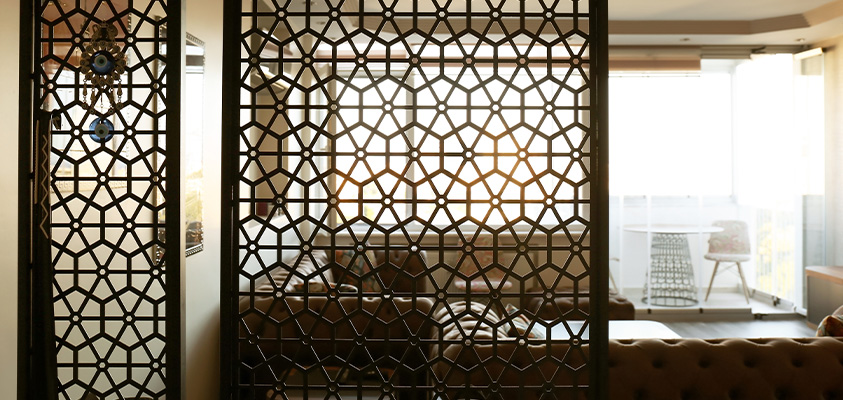
Many panels will use metal in the frame or fixings, but a solid metal room divider is best suited to more permanent room dividers. Metal has been used in furniture as far back as ancient times, but was popularised for modern use in the 1920s by designers such as Eames and Bertoia. Many modern pieces are inspired by the industrial era, with minimalist design and clean lines, but they can also be used for ornate pieces that match provincial, baroque or Victorian. With the proper care, it’s a very stylish addition to your home.
Pros of metal room dividers:
-
Durable.
-
Modern aesthetic.
-
Perfect for permanent dividers.
Cons of metal room dividers:
-
Can scratch floors.
-
Hard to move.
-
More expensive.
-
Can appear cold and unfeeling in the wrong decor.
Glass
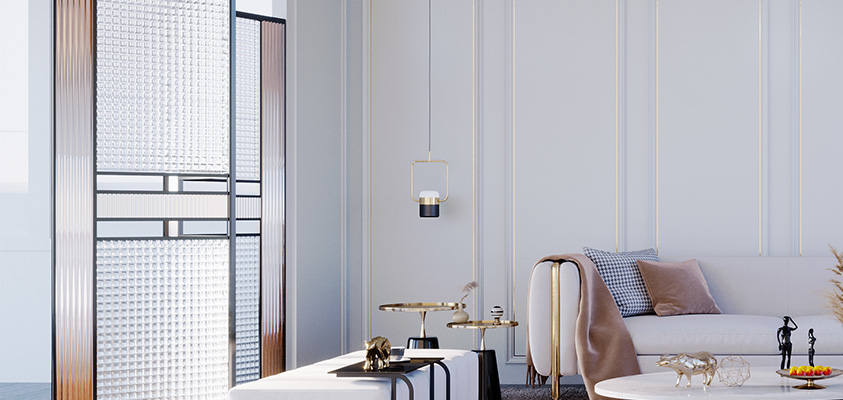
You’ve probably seen glass room dividers or wall partitions in commercial buildings or shopping centres. They give a clean, crisp, modern look, and can give you a clear view of your home while also giving you privacy. You can find clear glass, opaque glass, or even textured glass for a stunning artistic focal point.
Pros of glass room dividers:
-
Elegant look.
-
Durable (especially tempered glass).
-
Easy to clean.
-
Various textures, colours and clarity levels are available.
Cons of glass room dividers:
-
Easy to smudge.
-
Can be dangerous when broken.
-
More difficult and expensive to replace.
-
Tempered glass can be heavy.
Plastic
With all the features and benefits of glass without the fragility, plastic room dividers come in a wide range of styles, colours and compositions, with the most popular plastics being plexiglass and polycarbonate. Plastics are a cost-effective alternative compared to other organic products. They are also ideal for high-traffic commercial areas. This material suits mid-century modern and retro homes, as well as décor that celebrates bold colours.
Pros:
-
More cost-effective than other options.
-
Less likely to break.
-
Lightweight.
-
Cleaning is easy.
-
Water, fade, temperature and insect-resistant.
Cons:
-
Not the same clarity as glass.
-
Some plastics are more susceptible to scratches.
-
Not as aesthetically pleasing as other screens.
Plants?
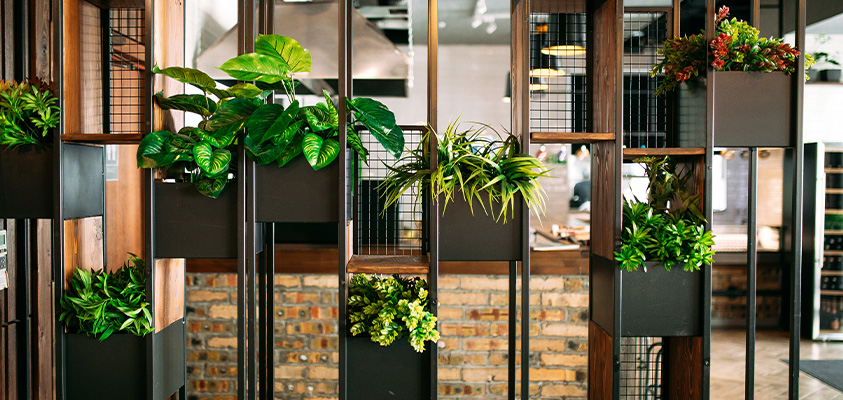
Yep, you heard right! Flower walls are no longer just a feature of your garden. You can find room dividers that hold your favourite indoor pots, or a climbing wall for your plants to grow and flourish. You can even use plastic plants, although they may not have the same aesthetic appeal. You’ll want to be careful about the kind of frame you use to house your plants - make sure the material is pest and water-resistant.
Pros:
-
Beautiful, natural look.
-
Extra space for plant lovers.
Cons:
-
Plant care is required.
-
Plants may affect the room divider frame.
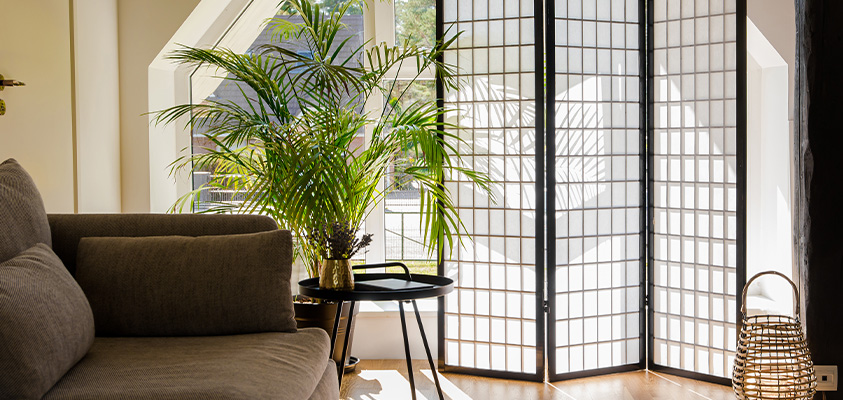
One of the top Aussie brands on the market, Artiss offers a huge range of furniture and décor, perfect for anyone trying to create their own unique space. Save time browsing and shop online with Artiss today. Explore the full collection or filter your search by panel size (two, four or six panels) and price range to find some of the hottest deals in the Australian market. From hassle-free shipping to Australia-wide delivery, Artiss makes it easy to get what you need delivered to your doorstep. With reliable Australia-based customer care, it's easy to see why we're one of the top brands on Aussie marketplaces. We're always launching new products: sign up to our mailing list for exclusive access to our latest deals. Find even more deals and more top brands when shopping with our partnered retailers such as Amazon, eBay, Catch and Kogan. Shop our range of room dividers to help you create your brand-new dream space today, or check out our blog and view even more popular pages on styling, buying, and better living.








